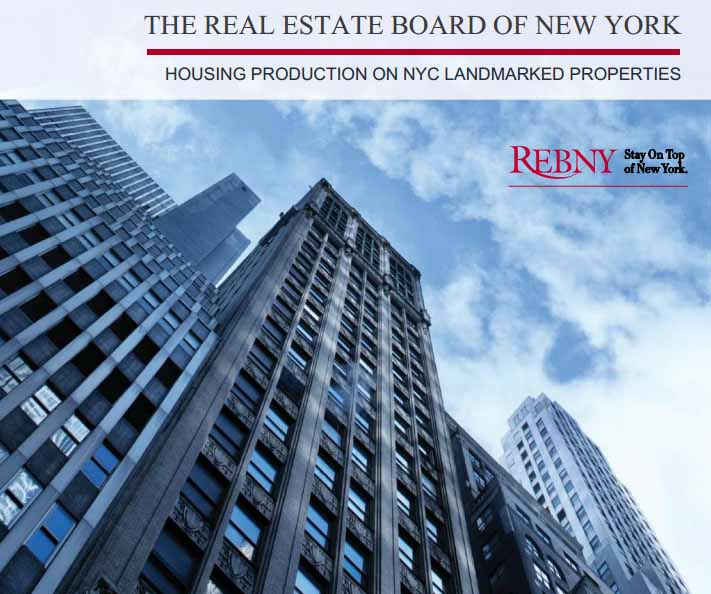HISTORIC DISTRICTS COUNCIL
June 2014 Volume 11, Number 5
——————————————————————————————————
The Historic Districts Council Analysis of
The Real Estates Board of New York’s
‘Housing Production on NYC Landmark Properties’ Study
The Real Estate Board of New York (REBNY) is at it again! To welcome new LPC Chair Meenakshi Srinivasan on her first day, the trade association and lobbying group released yet another study claiming that landmark designation inhibits the development of affordable housing and is at odds with the de Blasio’s administration’s goals of preserving and creating 200,000 units of affordable housing over the next ten years. REBNY’s complaints are nothing new, they are based on the group’s long-held and often-repeated premise that building on a landmarked site is so expensive and arduous that no one would ever want to do it.
Using a selective comprehension of statistics, the study shows that the percentage of affordable housing created on landmarked property from 2003-2012 was much lower than on non-designated property. Given that the percentage of affordable housing developed over that period was only 16.94% of the total property development in New York City, their argument begins to look a little skewed. The crisis in affordable housing which has finally captured the public’s attention is not a landmarking issue; this is a deeper indictment of the real estate market to provide for the needs of New Yorkers and the subtle failure of government to guide market forces to help meet that need.
According to the REBNY study, only 3.64% of New York City is landmarked but “‘an astonishingly high 27.71%’ [of Manhattan is] designated”. This is neither astonishing nor remarkable. Despite concentrated efforts by the Landmarks Preservation Commission during the Bloomberg administration, boroughs outside of Manhattan remain under-represented among the designated historic districts due to a number of understandable but unfortunate historical reasons. We have every reason to believe that under the new administration, designation activity throughout the city will continue based on merit and community participation and this inequity will continue to be addressed. Finally, New York City’s affordable housing crisis is more pronounced in its outer boroughs, where there has been minimal designation by LPC. The focus on the lack of affordable housing in Manhattan due to district designation trivializes a very complex and serious issue.
Something that the REBNY report states but their press release does not trumpet is that during the 2003-2012 time period in question, 412 affordable housing units were created on landmark properties through renovation. Compare that to the 1,318 units constructed on landmark properties during the same period, and the numbers start looking different.
The Landmarks Commission itself answered these same charges when they were leveled by REBNY in September 2013 in an earlier previous report they issued on why they felt landmark designation was bad for New York. The LPC said:
[The report] fails to recognize the obvious: the purpose of the landmarking law is not to facilitate new construction; it is to preserve historic buildings and neighborhoods. So the finding that new affordable housing construction in landmarked buildings and districts has been limited is hardly a surprise. More interesting to your readers – and to those who are genuinely interested in affordable housing – is that more than 1,100 units of affordable housing have been created or preserved in historic districts citywide since 2004, and [recently] an affordable development was proposed in the Gramercy Historic District. The Bloomberg Administration has built and preserved more affordable housing units than any other city in the country – enough to house the entire city of Atlanta – and we have done it without sacrificing the historical character of the city, which adds both financial and civic value to neighborhoods. Affordable housing and historic preservation can go hand-in-hand.
To which we can only add, the only reason which we think that landmark designation might add to the housing crisis is that by preserving the architectural integrity of a beautiful historic city, lots of people want live here.
To read REBNY’s whole study click here
——————————————————————————————————
‘The Historic Districts Council says the city’s historic districts are not to blame for the shortage of affordable housing’
New York Daily News
By Jeffrey Kroessler
“If REBNY claims that historic districts truly stifle the construction of affordable housing, we should ask just how many affordable units are being built outside those protected districts. The answer is “not many.”
And before we blame the landmarks law as the impediment, is there actually an instance when the Landmarks Preservation Commission has denied such an application? The answer is no.
Many more people want to live in historic districts than are able to given the existing housing stock, but does that result in higher rents? Are rents in historic districts really higher than rents just outside the district, or 10 blocks away? In actuality there is very little difference, especially in the older buildings and, of course, rents are rising everywhere. Landmark designation is not the variable.”
To read the full article here
——————————————————————————————————
‘HDC Defends NYC Landmark Preservation’
City Land
Commentary by HDC Executive Director Simeon Bankoff
In truth, despite almost 50 years of the Landmarks Law, less than 4 percent of New York City’s properties are protected by landmark designation. Statistics and numbers can be manipulated endlessly and yes, within a historic district, it’s true that you are surrounded by landmark buildings. But look at a map of the city or even only of Manhattan and it’s surprising how little is actually designated. Of those few areas, though, the effects are remarkable. Brooklyn Heights, Greenwich Village, Fort Greene, the Upper West Side, Tribeca, Dumbo – the list of neighborhoods which have improved in terms of services, housing and value since becoming historic districts goes on and on. Even areas outside of the City’s core such as Jackson Heights, Ditmas Park and Saint George have seen remarkable prosperity since designation.
To read the full article here




